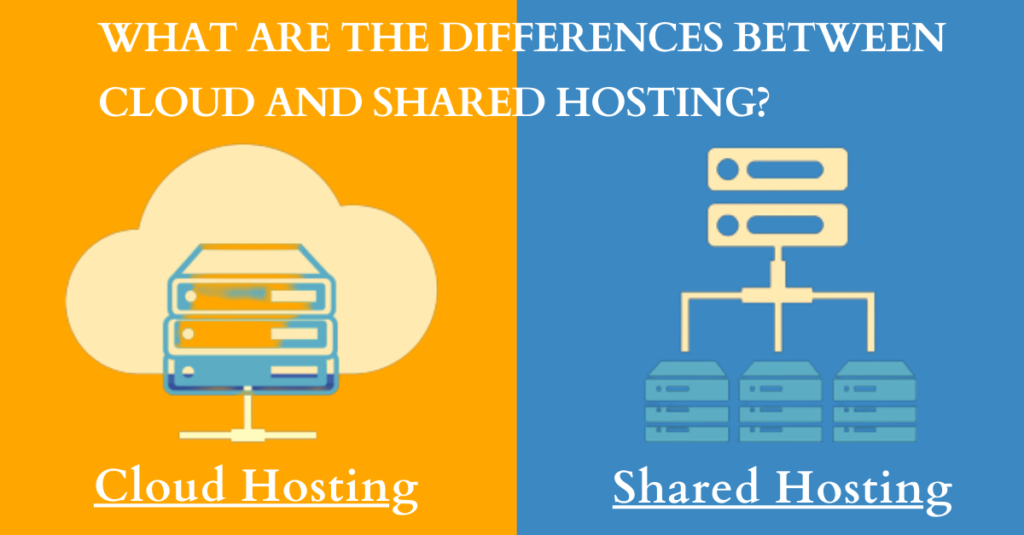What Are the Differences Between Cloud and Shared Hosting?
Introduction
In today’s digital age, a strong online presence is essential for individuals and businesses alike. Behind the scenes of every website, a reliable web hosting service plays a critical role in ensuring seamless accessibility and optimal performance. Among the plethora of hosting options available, two prominent contenders are cloud hosting and shared hosting. Each approach comes with its own set of benefits and limitations, catering to different needs and objectives. In this article, we will delve into the nuances that set cloud hosting and shared hosting apart, examining factors such as performance, scalability, reliability, control, security, and cost.
Understanding Cloud Hosting

Cloud hosting has gained immense popularity in recent years due to its innovative and dynamic nature. Unlike traditional hosting methods, cloud hosting operates on a network of interconnected virtual servers. These servers work in tandem to ensure that resources are readily available and can be scaled up or down as needed. This scalability is a game-changer for businesses with fluctuating traffic patterns. One of the standout features of cloud hosting is its ability to handle traffic spikes effortlessly, ensuring a consistently smooth user experience.
The redundancy offered by cloud hosting is another noteworthy feature. In the event that one server experiences an issue, the workload is automatically shifted to other servers in the cluster. This redundancy guarantees minimal downtime and maximizes the uptime of websites hosted on the cloud.
Moreover, cloud hosting follows a pay-as-you-go model, allowing users to pay only for the resources they consume. This cost-effective approach eliminates the need for heavy upfront investments, making it an attractive option for startups and small businesses.
Exploring Shared Hosting

Shared hosting, on the other hand, is a more traditional hosting method that caters to individuals and businesses with moderate website needs. In a shared hosting environment, multiple websites share the resources of a single physical server. This approach makes shared hosting an economical choice, as the costs are distributed among the various users.
Shared hosting providers manage server maintenance and technical aspects, relieving users of the need for advanced technical expertise. This hands-off approach is particularly beneficial for those who are new to web hosting and want a hassle-free experience.
However, shared hosting does have its limitations. Since resources are shared among multiple users, the performance of one website can potentially impact others on the same server. During peak traffic times, this can result in slower loading speeds and reduced overall performance. Additionally, customization options are limited in shared hosting environments, as users have restricted access to server settings and configurations.
Performance and Scalability Comparison
Performance is a critical factor in web hosting, as it directly influences user experience and search engine rankings. Cloud hosting often outperforms shared hosting in this aspect due to its inherent scalability and resource allocation. Cloud hosting allows websites to tap into a vast pool of resources, ensuring that performance remains consistent even during traffic spikes.
Shared hosting, however, can be more susceptible to performance issues, especially when neighboring websites experience high traffic volumes. Since resources are divided among multiple users, heavy resource consumption by one website can lead to decreased performance for others. While shared hosting providers implement measures to mitigate such scenarios, performance fluctuations can still occur.
Reliability and Uptime Assurance
Reliability and uptime are crucial for any website’s success. Cloud hosting’s redundant architecture provides a higher level of reliability compared to shared hosting. If one server within the cloud experiences a hardware failure or technical issue, the workload is automatically shifted to other available servers. This ensures that websites experience minimal downtime and maintain high uptime percentages.
In shared hosting, the reliance on a single physical server introduces a higher risk of downtime due to hardware failures or maintenance. While shared hosting providers do strive to maintain uptime, the shared nature of resources makes it challenging to offer the same level of reliability as cloud hosting.
Customization and Control Levels
When it comes to customization and control, cloud hosting takes the lead. Cloud hosting users typically have root access to their virtual servers, enabling them to configure and customize their hosting environment according to their specific needs. This level of control is invaluable for businesses requiring specific software installations or configurations.
Shared hosting, due to its shared resource nature, imposes limitations on customization and control. Users have restricted access to server settings, and software installations may be limited to what the hosting provider supports. While this may not be an issue for smaller websites with standard requirements, businesses with unique needs might find shared hosting’s limitations restrictive.
Security Comparison
Security is a paramount concern for any online venture. Cloud hosting providers often offer robust security measures, including isolated virtual environments, firewalls, and regular security updates. The isolation of virtual servers in cloud hosting prevents security breaches on one website from affecting others.
Shared hosting’s security landscape can be more complex. While providers implement security measures, the shared environment exposes websites to potential vulnerabilities. If one website on the server experiences a security breach, it could potentially impact others on the same server. However, with proper security measures and regular updates, shared hosting can still provide a secure environment for smaller websites.
Cost Analysis
Cost considerations play a significant role in the hosting decision-making process. Cloud hosting’s pay-as-you-go model allows users to pay only for the resources they use. This flexibility is particularly advantageous for businesses with unpredictable traffic patterns, as they can scale resources up or down based on demand. However, while cloud hosting offers great scalability, costs can increase rapidly if usage spikes unexpectedly.
Shared hosting’s cost-effectiveness stems from resource sharing. The expenses are distributed among multiple users, making it an affordable option for individuals and small businesses. However, shared hosting’s fixed resource allocation might lead to limitations during traffic spikes, potentially affecting performance.
Use Cases and Recommendations
The choice between cloud hosting and shared hosting largely depends on individual needs and goals. Cloud hosting is well-suited for businesses with fluctuating traffic, resource-intensive applications, and a need for customization. On the other hand, shared hosting is ideal for personal blogs, small websites, and those who value simplicity and affordability.
For startups with limited budgets, shared hosting offers a cost-effective entry point into the online space. As their websites grow and traffic increases, transitioning to cloud hosting might become a consideration to ensure seamless performance and scalability.
Conclusion
In the dynamic world of web hosting, choosing between cloud hosting and shared hosting requires careful consideration of various factors. While cloud hosting offers unparalleled scalability, performance, and customization, shared hosting provides an economical solution with managed technical aspects. As the digital landscape continues to evolve, understanding the differences between these two hosting models empowers individuals and businesses to make informed decisions tailored to their specific needs, ultimately shaping the success of their online endeavors.

My name is Rohit Vagh and I’m a content writer specializing in fashion and lifestyle. I have three years of experience in this field and have written various articles. My writing style is creative and engaging, and I strive to create content that resonates with my readers. I have a deep passion for fashion and am constantly researching the latest trends and styles to make sure my readers are up to date. I’m excited to continue my career in blogging, and I’m always looking for new opportunities in the fashion and lifestyle space.





